Here is my computer story....
Once upon a time, there were two little numbers - 1 and 0...
I got into the computer industry because I needed a source of income. By the mid-1970s, it was getting harder to make money being a musician, and I had young mouths to feed. I had opportunities to make lots of money by moving to Hollywood and doing film scores, but I turned these down. It was better that I made money doing computer programming, which was fun, rather than by having to creates somebody else's music. I felt that this would be an impediment to creating my own personal music, which was so radically different.
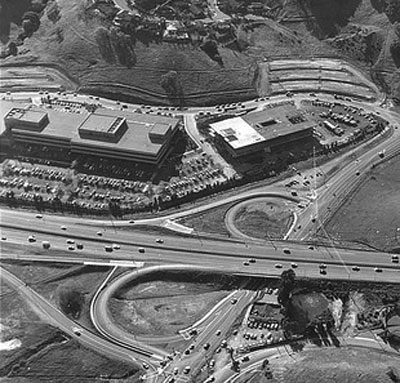
Fireman's Fund
My computer story begins in 1976 when I found myself living in wealthy Marin County, California, penniless, jobless, and with no means of earning a living other than being a musician. There was one skill that I could call upon, however, and that was typing. I practiced my typing at a neighborhood office, and then got a temporary job at nearby Fireman's Fund Insurance Company, whose data center was at that time located on Highway 101 and Lucas Valley Road, as shown in the photo above. The job paid $3.36 an hour and I was told it would last only a few months. I told them that once I got my foot in the door, I would stay forever if I wanted, and that's what happened. Well, I didn't stay forever.
My job at first was simply opening mail and sorting it. Across the isle from me, however, sat the first computer terminals that I had ever seen, the data-entry points for Fireman's Fund's life insurance division. I remembered my boyhood tinkering with electronics and I said to myself "That's for me."
I worked my way into auditing a company programming class already underway by memorized the text books. I soon caught up with my classmates who had been studying already for about six months, and then quickly became one of two lead students.
I realized that I easily mastered computer languages and I continued to study on my own, determined to learn systems programming. I now had access to the company's computer manual library, which was practically unused by the application programmers there, and I checked out manual after manual, reading them at home at night and on the weekends. At first I could not understand what I was reading because of so many terms that I was not familiar with, but I read the manuals anyway, until soon everything began to unfold for me.
When the class took a summer break, I continued studying on my own and within a year, I was hired by the programming department of Fireman's Fund as an assembly language programmer.
|
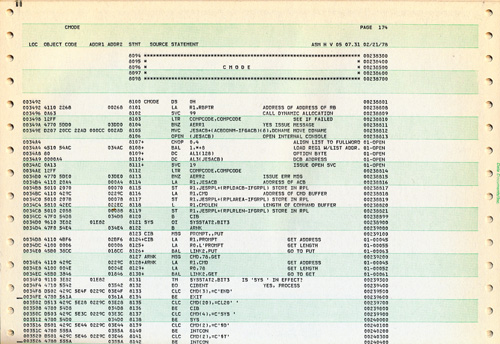
Hacking the Mainframe
Learning how the IBM OS/360 Operating System (the software that ran the mainframe computers at Fireman's Fund) worked was a fascinating journey, and I spent about a year on this venture. After studying the manuals, the next step for me was to study the actual code, the IBM code that ran the terminals, the printers, managed tasks, and so on. For this, I would need to get out of my "I am just a programmer" box that I was confined to. In other words, I would have to break into the restricted-access areas to access IBM's source code and get printouts of it to take home with me to study. This effort took me about six months.
I was able to find some source code for the IBM operating system, enough to start figuring out what it was that I needed to do to get into this cyberfont of knowledge. I would need to get past password protections and gain what was called "protect key zero." This would not be an easy task. However, I had made friends with another programmer, a very brilliant one, whom, I realized, had accomplished this, and I knew it could be done. It took six months for me to discover the secret, but once I figured out how to get past the barriers, and I had proved to my friend that I had done so, we started talking. He showed me the source code for the "terminal monitor" program, the program that was called up when a programmer logged into the main frame. I took this and expanded it, using the knowledge that I was gaining from study, and soon I had my own personal program that could do anything that I wanted it to do!
Because I now had the power to do anything, including modifying the accounting system, I had to keep my program secret. I assigned it to run from my terminal, but from no one else's.
My program had all kinds of secret commands, the most powerful being CMODE (pictured above). CMODE stood for "console mode." When I typed that command, my terminal became a computer console. There were only three computer consoles at fireman's fund, one for each mainframe, and these were located in the high security computer room behind man-trap doors. Now I had created the forth one at my desk. I accomplished this feat by using source code that I had discovered that was a part of a larger IBM software product called the Houston Automatic Spooling Priority.
|
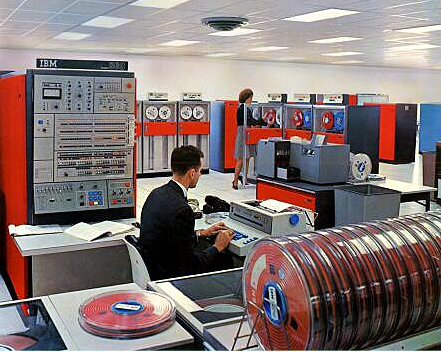
I Am Now in Charge!
My goal now was to get a job in Fireman's Fund's "tech staff": the guys (and a few gals) who took care of the operating system.... the gurus. I continued to work on my programming jobs as they were assigned me, but I had gained a great deal of extra time because of my ability to raise the priority of my print jobs, and while my co-workers waited all day for printouts to be delivered to them from the computer room, mine came within minutes. If a printer wasn't available, I just started one. Meanwhile I continued learning, writing experimental programs that ran in the restricted areas of memory.
Meanwhile, I had initiated conversations with the man who ran tech staff, a very friendly man who was very interested in my progress and my goal to join his staff. He realized that somehow I had gained access to the operating system and that I was operating at a very precarious level, but he must have trusted me. It was in his interest that I know what I was doing, and so he passed on to me all the training materials for the operating system that he had studied in his IBM training courses, and he gave me full access to the microfiche library that contained all of the source code, and now I really began learning!
Meanwhile, upstairs in the applications area where I worked, I became the go-to guy for reading and understanding what were called core dumps. When the programmers that I worked with executed their programs and they terminated abnormally, they had no idea how to fix the problem in their code because they had no knowledge of assembly language: the language of the dump printouts. Their normal practice was to just try changing various things, execute the program again, then wait all day for the printout. I would simply fix their problem immediately by reading and understanding the core dump that came with the offending program.
The great room full of cubicles where I worked was called the application programmers area. I would guess that 100 people worked in that room. I was shocked when I first got arrived, finding so little work being done the the programmers. Sometimes people slept in their cubicles, others took 3-hour lunch hours every day. If the programs that they maintained were running OK that day, and there were no new enhancements to add, well... it was cruise time. This was quite different than my previous experience as a clerk in that now far away part of the building.
|
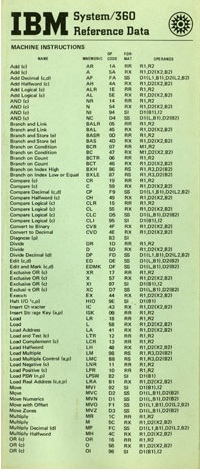
Tech Staff
My friend, the vice-president who ran tech staff, started giving me what are called "system dumps," the core dumps that occurred when one of the mainframes themselves crashed. These I pursued with relish! Soon I was able to figure out what caused these pesky system crashes by pursuing the system dumps and reading microfiche for the source code. I would check my findings with my friend, the vice-president in charge of Tech Staff, to see if I were right.
Meanwhile, I was having lots of fun experimenting after hours, when everyone else in the applications programming area had gone home. Animation did not really exist on these computers and I figured out a way to create comic animation by quickly changing screens, one after another. I created a simple program that displayed a man waving his hand and saying "Good-bye." Using my unlimited access to the computer's restricted regions, I sometimes would place this program into the logoff chain in the JCL that governed the programmers as they logged off of their terminals, and then watch my fellow programmers freak out when this crazy thing took over their screen when they exited their computer sessions.
Finally, I created a program that was the most fun of all. I must have worked on it for weeks. When someone walked away from their terminal, I would secretly load this program, and when they returned, as they typed in their commands, they would get completely incorrect responses, replete with fake threats from the computer room operators.
Meanwhile I waited for a position to open in tech staff. Unfortunately, the lady that I worked for disliked me. She was a mean-spirited person and people did not like her, and she was after me with a vengeance. She gave me bad performance reviews, on which I would challenge her. She liked to criticize people in our staff meetings, embarrassing them in front of everyone else. One time she took me to task during a meeting for being one of the the highest users of computer time in the whole company. She acted like I had committed a crime! I quickly fixed that little annoyance. I added a piece of code to my terminal monitor program that when I was finished with my computer sessions, it would ask me how much time I wanted to tell the system I spent on that session. I would make up a time (usually hours shorter than the actual time), and that would be the time that went on record. This was a simple thing to do. There was a place in the Address Space Control Block for this number to go. When the next staff meeting was held, she complemented me on how great I was doing with my computer time. She was genuinely surprised.
|
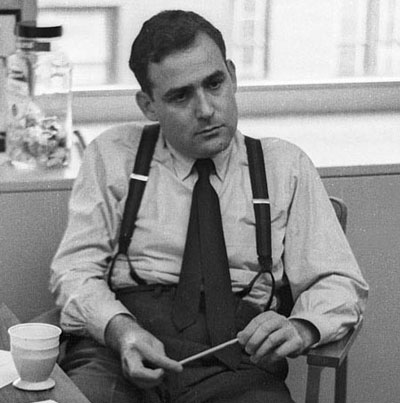
H&A Computer Systems
Well, the time finally came. I was hired into a newly vacated position on tech staff and I started moving my stuff downstairs into the new area. This was great! However, I soon got a call from my new supervisor, and I was told that I could not take the new position because I would be moving from a Grade 6 trainee position to a Grade 9. The legal department had blocked my transfer, fearing a class-action suit from programmers who had been in the company longer than I had been.
Well that was it for me. I was "outta there."
I had made friends with a man named Nick Nickerson at Fireman's Fund. He had left the company to work with a friend named Alan Hochschild (pictured in the photo above) and they were developing software in Hochschild's basement in San Francisco. They were writing operating system code for an IBM mini computer called the Series/1. Nick had invited me to join them, and now that there was no upward path for me at Fireman's Fund, I accepted the job. After writing a scathing exit interview concerning the lady that I had worked for, I was gone.
There were just four of us at the new job: Alan, Nick, myself, and a brilliant young programmer named Tim Thornburn. We were called H&A Computer Systems
Here we were in the basement of this beautiful San Francisco home, just down the road from that of filmmaker Francis Ford Coppola, and we had this little machine, the Series/1, about 4-foot high, that had really no operating system at all. When you wanted to do anything, you had to put big 7-inch floppies into the machine and type in exact addresses on the disk drives where things were located, addresses that we kept track of on paper!
What we were creating was a language that Alan and Nick had invented called PXS, and it would become the way for the Series/1 to work its way out of factories, where it had been formerly employed in process control, and into fortune 500 corporations. How was that going to happen, I wondered, as it was in such a primitive state? To compile one of our programs, we had to leave it with Alan to run at night, since this machine could only do one thing at a time.
|
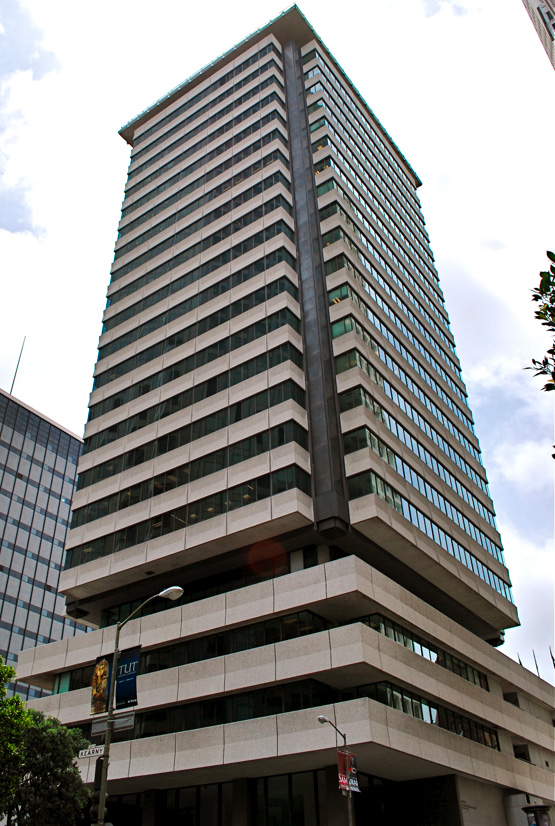
Downtown
Tim and I churned out the code that would provide the underpinnings of the new application language called PXS. One day, a representative from IBM came to the house and told us that there was now a new multitasking operating system for the machine that would make life easier. It was called EDX. With this new software in place, we were able to make terrific progress, and soon we had moved to 601 Montgomery Street in a very upscale office building across the street from the Transamerica Pyramid, a downtown San Francisco landmark.
We rolled out PXS and began gaining clients. Alan was a sharp business guy, and Nick was a brilliant software designer. We began taking on more employees and soon there were several dozen people in the office. Some were contractors, like Bernie, who worked part-time for us. It was 1981 and IBM had just announced the first PC. In his home in the evenings, Bernie was writing a program for this new personal platform. It would get stock-market quotes. Tim worked with Bernie in the evenings, writing communications code in exchange for a portion of the proceeds from the program, once it went into operation. I could see no reason to do this myself because Tim wasn't being paid, and I couldn't see the point. Well, this little program eventually turned into E-Trade, and "Bernie" (Bernard A. Newcomb), became one of America's wealthiest men and a great philanthropist. Tim came out alright too. Well, so much for short sight on my part!
Meanwhile, PXS was being used to create applications, just as Alan had predicted, and our code was going into the fortune 500s - Weyerhaeuser, Montgomery Wards, Mastercard (we verified all of the credit card requests made anywhere), ACME Boots, and many more.
Nick and I were busy working on a computer system for Aetna Life & Casualty. If we could run 18 terminals on a single Series'/1, then they would use our PXS language to write an agency automation system. Nick designed, and I wrote, a very sophisticated program loader, and this did the trick. From this point on, most my work would be for Aetna.
|
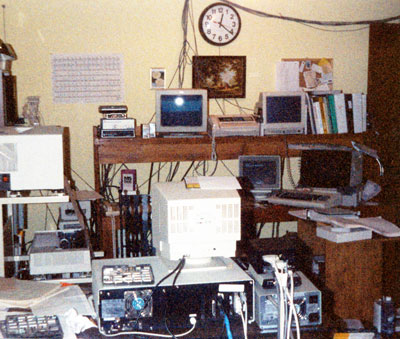
Colorado
In July, 1984, I packed a Series/1 into a U-Haul truck and moved my family to Colorado, my home state. I set up shop in our house in Fort Collins. I was now an independent consultant instead of a full-time employee, and I had my own company, DBR Network Systems, inc. I was working mostly with Aetna on the internals of the Agency Automation System, but I had a number of clients, including H&A.
In about 1988, IBM announced the end of the Series/1, and H&A began converting PXS to run on IBM's UNIX platform, called AIX. I moved to UNIX also, learning the various flavors, and often had 3 or 4 different loaner machines in my computer room for clients: machines from NCR, Burroughs Corporation, SCO, and Hewlett-Packard, all with different versions of UNIX.
I had a number of clients, including the Ford Motor Company, Freightliner trucks, and the Ralphs grocery store chain.
But to move ahead, I had been studying a complex networking protocol called SNA for a year. SNA was how computers communicated with IBM mainframes. It was a very difficult system to master, and thus gave me the kind of challenge I needed to make life interesting, to say nothing of the fact that it made me very valuable as a consultant, as few people even grasped its basics. When I had mastered this networking technology, I began specializing in the art of interconnecting various computers to mainframes, working with such large enterprises as the California Department of Motor Vehicles, the May Department Stores Company, and at Fieldcrest-Cannon, where I interconnected their mainframe with UNIX machines in the plant. I also wrote a 4mm tape device driver for AIX, maintained various 3270 terminal emulation programs, and wrote code for the dial-in service at Norwest Banks's data center in Denver. In addition to all of this, Aetna sent me three brand new PCs that they wanted me to interconnect with Novell Netware. All this along with two Series/1 mini computers.
About 1995, Aetna sold the Agency Automation System and soon my work there was over. It was time for another change.
|
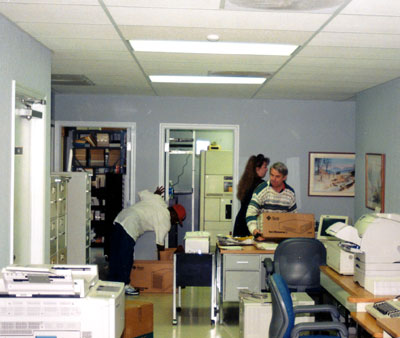
The Virginia DMV
In 1995 I decided to move to the South, where I was already researching gospel music. I was tired of Fort Collins, and wanted to live among people making great music, to some place where I was closer to my research.
One of my computer consulting clients was the Department of Motor Vehicles in Richmond, Virginia. They had been calling me every-so-often when they had networking problems that they couldn't solve, and I would come flying in on my white horse.
I decided to go to Richmond on one of these visits, and find a way to stay... and that is what I did. I stayed for four years. My company, DBR Network Systems, inc., had signed contracts with the Commonwealth of Virginia, and I worked as a contractor and consultant. Together with my friend and co-worker Chuck Duerson, I helped create new system software to replace all of the Series/1 machines in the branch offices, replacing the old Series/1 computers in the branch offices with new Sun Sparcstation machines. That's me in the photo above in the green and white sweater installing equipment in the branch in Hopewell, Virginia in 1998.
I also helped develop the DMV's first Website that included a revolutionary licence plate design feature, and I designed and implemented the DMV's Domain Name Server.
When the job was done at the DMV, I left. Four years was longer than I had ever expected to stay. But it had been a wonderful experience for me there. The people were friendly, kind, helpful, and Chuck Duerson and I formed a good partnership.
However, the stress level in the computer world was always high, and this was no exception. A year after I left, the man in charge of the computer rollout, and the work that Chuck and I accomplished, committed suicide in the parking lot of a 7-11. He was a young man with a wife and two small children. It was very sad.
|

The Computer Book
At the same time that I began my four-year contract with the Commonwealth of Virginia, I got a call from Jay Ranade, series editor for McGraw-Hill. He had read my article in IBM Internet Journal on IBM's MPTN architecture and offered me a book deal, which I took. I felt that I needed as much support as I could get as an independent computer consultant and contractor.
I signed the contracts, and then contacted IBM's System's Networking Division in Raleigh, North Carolina, informing them of my upcoming book and asking for assistance, which they were more than happy to give. We began with a few lengthy telephone conversations between myself and top SNA and networking systems engineers in Raleigh who were working on the MPTN project, including Diane Pozefsky, who in 2011 was awarded the Women in Technology International Hall of Fame Award for contributions to the fields of Science and Technology. I soon began one of a number of trips to Raleigh for meetings with the Anynet and SNA architects.
The subject of my book was a complex one, which made the project more interesting and intellectually stimulating. IBM's MPTN architecture was one of the proposed solutions to the networking dilemmas of the time, the interoperability of the different computer networking protocols such as TCP/IP, AppleTalk, Netbios,Novell, and IBM's own SNA. IBM's solution was to split protocol stacks to layer one flavor protocol to run on top of others: any-to-any, or AnyNet, as they called it.
My book, Accessing Transport Networks took me almost two years to write, and when I had completed it, I vowed to never write another computer book or magazine article again! I painfully realized that those two years of spare time could have been devoted to writing the books that I was really interested in: my own books... books about music, not computers.
|
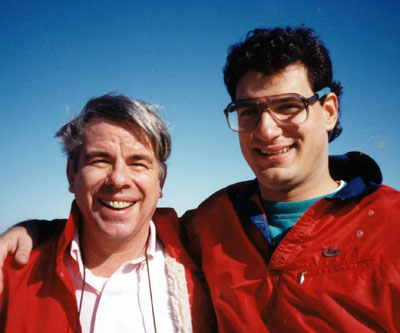
MindShare Systems
In November, 1999, after four years at DMV, my new wife, Mary Ellen Bickford, and I moved to Georgia, and I became the Chief Technology Officer for a company that was formed by my friend Al Masullo.
Al's company was called MindShare Systems. Al and I had worked together when he was a computer engineer at Aetna. He offered me stock in the company and they were bringing lots of money. I started January 1, 2000, and yes, that first year was fantastic financially. Al purchased a building for us and built a large data center in it. However, in 2001, the computer industry bubble burst, and suddenly our clients began to disappear, going bankrupt, and budgets were being drastically cut. The company took a downturn, and I left in 2002 to concentrate on my music.
As I said before, there was a lot of stress in the industry. The man with whom I had worked at the Virginia DMV had committed suicide about a year after I left. The same thing happened again. Mary Ellen and I moved to Nashville in November, 2011, and when we arrived, I received a phone call from Atlanta. My friend Al Masullo had put a gun to his head and pulled the trigger. Now HE was gone too.
But my days in the computer industry were finally over, and I couldn't be more happier about that. I would devote my time to my purpose in life.
It was time to change the music.....
|
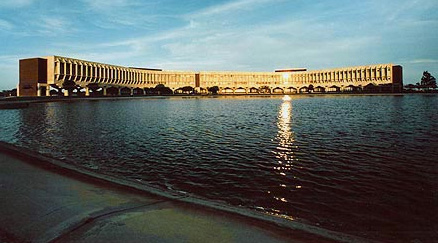
IBM Headquarters in Boca Raton during the 1980s
An Aside: Down in the Dumps
My core dump-reading skills came in handy all of the time. For example, there was a bug that was plaguing the Aetna Agency Automation System, now running in, I think it was, around 1,200 independent insurance agencies in America, Aetna suspected a problem in the hardware and a team of IBM and Aetna engineers were going around the country from office to office trying to discover what was causing the problem. Finally exasperated, IBM called a meeting at its headquarters in Boca Raton, Florida, and everyone that had anything to do with the Automation System was summoned, including me. It was scheduled as a 3-day affair, extravagantly catered, and all the Series/1 hardware and software heavyweights were in attendance in a large room, a small auditorium. Each person got up and talked about the problem and was probed with questions.
When my turn finally came near the end of the first day, I told the distinguished audience that they were going about the problem in the wrong way. I suggested that the 3-day meeting be canceled and that they send me to an office were the problem was occurring frequently. I would get a system dump and determine if it were a software problem. It sounded to me like it was.
IBM followed my suggestion and four of us rented a car and drove across Florida to Fort Myers, where the chosen agency was located. Within 15 minutes, I had my core dump on a 7" floppy in hand, and we drove back to Boca Raton, printed the dump, and while my compatriots jet-skied on the beach, I studied the dump, found the bug, called the programmer responsible (it was a single line of code that needed to be changed), and the problem was quickly solved. I wonder how many thousands of dollars it had cost to have gotten nowhere!
|
|
|
|
|



